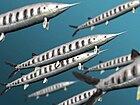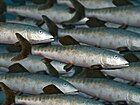
Actinopterygii, members of which are known as ray-finned fish or actinopterygians, is a class of bony fish that comprise over 50% of living vertebrate species. They are so called because of their lightly built fins made of webbings of skin supported by radially extended thin bony spines called lepidotrichia, as opposed to the bulkier, fleshy lobed fins of the sister class Sarcopterygii. Resembling folding fans, the actinopterygian fins can easily change shape and wetted area, providing superior thrust-to-weight ratios per movement compared to sarcopterygian and chondrichthyian fins. The fin rays attach directly to the proximal or basal skeletal elements, the radials, which represent the articulation between these fins and the internal skeleton.

The Amiiformes order of fish has only two extant species, the bowfins: Amia calva and Amia ocellicauda, the latter recognized as a separate species in 2022. These Amiiformes are found in the freshwater systems of North America, in the United States and parts of southern Canada. They live in freshwater streams, rivers, and swamps. The order first appeared in the Triassic, and the extinct members include both marine and freshwater species, many of which are morphologically disparate from bowfins, such as the caturids.
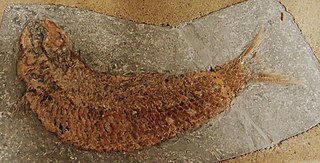
Pholidophorus is an extinct genus of stem-teleost fish. Numerous species were assigned to this genus in the past, but only the type species Pholidophorus latiusculus, from the Late Triassic of Europe, is considered to be a valid member of the genus today.

Leptolepis is an extinct genus of stem-teleost fish that lived in what is now Europe during the Jurassic period.

Holostei is a group of ray-finned bony fish. It is divided into two major clades, the Halecomorphi, represented by the single living genus, Amia with two species, the bowfins, as well as the Ginglymodi, the sole living representatives being the gars (Lepisosteidae), represented by seven living species in two genera. The earliest members of the clade, which are putative "semionotiforms" such as Acentrophorus and Archaeolepidotus, are known from the Middle to Late Permian and are among the earliest known neopterygians.
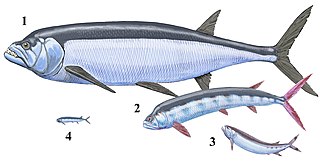
Ichthyodectiformes is an extinct order of marine stem-teleost ray-finned fish. The order is named after the genus Ichthyodectes, established by Edward Drinker Cope in 1870. Ichthyodectiforms are usually considered to be some of the closest relatives of the teleost crown group.

Pachycormiformes is an extinct order of marine ray-finned fish known from the Early Jurassic to the end of the Cretaceous. It only includes a single family, Pachycormidae. They were characterized by having serrated pectoral fins, reduced pelvic fins and a bony rostrum. Pachycormiformes are morphologically diverse, containing both tuna and swordfish-like carnivorous forms, as well as edentulous suspension-feeding forms.
Bobbichthys is an extinct genus of marine ray-finned fish that lived in what is now Chile during the Oxfordian stage of the Late Jurassic epoch. It was a member of the Varasichthyidae, a family of potentially crossognathiform fish.
Helmolepis is an extinct genus of ray-finned fish that lived during the Early Triassic epoch in what is now Greenland, Madagascar and Canada. Species of Helmolepis are small. This genus is closely related with Platysiagum.
Ascalabos is an extinct genus of marine ray-finned fish known from the Late Jurassic Solnhofen Limestone of Germany. It contains one species, A. voithii. Some authorities synonymize it with Leptolepis.

Prohalecites is an extinct genus of ray-finned fish from the Ladinian and possibly Carnian (Triassic) of Italy. It is the oldest known teleosteomorph, a group that includes extant teleosts and their close fossil relatives.
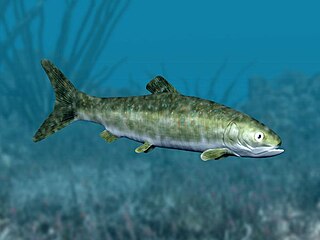
Ichthyokentema ("fish-goad") is an extinct genus of stem-teleost fish that lived during the Late Jurassic. It contains one species, I. purbeckensis, which is known from the Purbeck Group of Dorset, England. I. purbeckensis was originally described as a species of Pholidophorus by William Davies in 1887, but was moved to its own genus by Arthur Smith Woodward in 1941.
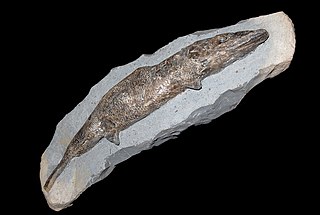
Crossognathiformes is an extinct order of ray-finned fish that lived from the Late Jurassic to the Eocene. Its phylogenetic placement is disputed; some authors have recovered it as part of the teleost stem group, while others place it in a basal position within crown group Teleostei.
This list of fossil fishes described in 2013 is a list of new taxa of placoderms, fossil cartilaginous fishes and bony fishess of every kind that have been described during the year 2013. The list only includes taxa at the level of genus or species.

Orthogonikleithrus is a genus of extinct ray-finned fish that lived during the Late Jurassic period. It lived in lagoonal and restricted shallow subtidal zones.

Teleosteomorpha is a clade of ray-finned fishes containing all teleost fish and their closest extinct relatives. Also in this group are two diverse Mesozoic fish orders, the Aspidorhynchiformes and the Pachycormiformes. Several other non-teleostomorph teleosteans existed throughout the Mesozoic, although not as dominant as the two main clades in the group.

Ginglymodi is a clade of ray-finned fish containing modern-day gars (Lepisosteidae) & their extinct relatives in the order Lepisosteiformes, the extinct orders Semionotiformes and Kyphosichthyiformes, and various other extinct taxa. Ginglymodi is one of the two major subgroups of the infraclass Holostei, the other one being Halecomorphi, which contains the bowfin and eyespot bowfin and their fossil relatives.
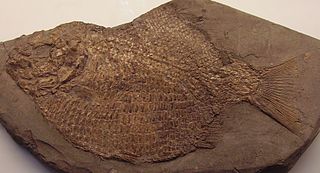
Dapediidae is an extinct family of neopterygian ray-finned fish that lived from the Middle Triassic to Late Jurassic. It is the only family of the order Dapediiformes. Its members were historically placed within the ginglymodian family Semionotidae, but were moved to their own family in 1966.
Siyuichthyidae is an extinct family of stem-teleost fish known from the Early Cretaceous Tugulu Group of Xinjiang, China. It contains five genera with a total of nine species, all of which are based on poor remains.

Pholidophoridae is an extinct family of primitive stem-teleost fish that lived during the Triassic period, from the Anisian age of the Middle Triassic to the Norian age of the Late Triassic. Most of the genera are from Europe, but one (Malingichthys) is known from China. The pholidophorids were historically united with several other stem-teleost lineages into the order Pholidophoriformes, but Pholidophoriformes in its traditional sense is now considered paraphyletic with respect to crown group teleosts.

















